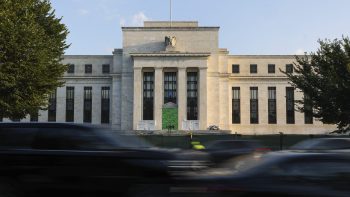Quantitative easing: A ‘nuclear option’
TEXT OF STORY
Stacey Vanek-Smith: The Federal Reserve meets today and tomorrow to discuss another interest rate cut. Rate cuts are supposed to help spur lending in the economy. But here’s the thing: the rate is 1 percent right now, and the Fed’s expected to cut it in half. That would be a record low — and pretty darn close to zero. So what does Uncle Sam do when it’s lowered rates all it can and the credit markets still aren’t moving? Quantitative Easing, that’s what. And it’s the topic of our latest Marketplace Decoder.
Marketplace Stephen Beard explains “Quantitative Easing” and looks at how the Fed could use this little-known monetary tool.
Stephen Beard: This is the last monetary wrench in the Fed’s toolbox — the nuclear option.
Economist Andrew Hilton says Quantitative Easing is what you do to get people borrowing and spending after everything else has failed:
Andrew Hilton: What it is is an attempt by central banks to pump liquidity into the system even when interest rates are close to zero.
Lowering short-term interest rates is usually the way to increase money supply. But when central banks can’t cut rates any further, they can turn to Quantitative Easing. They can print a lot more money, and spend billions buying long-term government bonds. That floods the economy with extra cash. And it pushes long-term interest rates lower:
Graham Turner: That will bring down borrowing costs for mortgages and corporate loans.
Graham Turner of GFC Economics:
Tuner: You’re trying to do this to stop people defaulting. We absolutely need to move towards this kind of policy.
But some economists, like Andrew Hilton, are distinctly uneasy about Quantitative Easing:
Hilton: We are now up to our knees in liquidity, up to our knees in cash. This kind of shift in policy will mean that we will be up to our waists in cash. And who knows what’s going to happen two or three years down the line? It is perfectly possible that we could have double-digit inflation.
Too much cash chasing too few goods, pushing up prices — the textbook definition of inflation. But supporters of Quantitative Easing say that deflation, falling prices leading to mass bankruptcies and unemployment, that’s the real danger.
Charles Goodheart: Let’s get out of the hole we’re in before we worry about the next hole along the road.
Former British central banker Charles Goodheart says since rock-bottom interest rates have failed to spur spending in the States and in the U.K. the case for quantitative easing will soon be overwhelming:
Goodheart: It’s not normal, it’s not standard, but if you’ve got yourself into the kind of financial and economic crisis that our countries have, it is actually what you have to do.
But the critics say there is no guarantee that Quantitative Easing will work. It still may not solve the fundamental problem — the lack of trust, and therefore lending, between banks. And as the recession deepens and the banks grow more fearful of default, trust seems as elusive as ever.
In London, this is Stephen Beard for Marketplace.
There’s a lot happening in the world. Through it all, Marketplace is here for you.
You rely on Marketplace to break down the world’s events and tell you how it affects you in a fact-based, approachable way. We rely on your financial support to keep making that possible.
Your donation today powers the independent journalism that you rely on. For just $5/month, you can help sustain Marketplace so we can keep reporting on the things that matter to you.


















